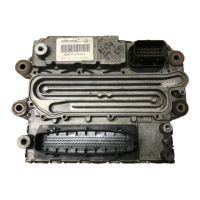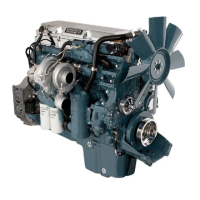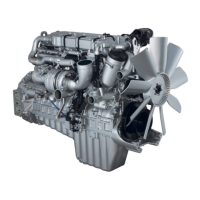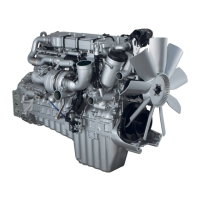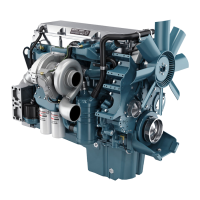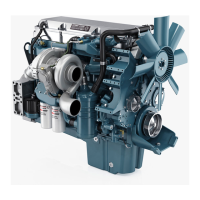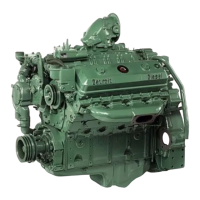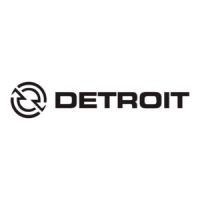
Do you have a question about the Detroit Diesel V-71 and is the answer not in the manual?
| Engine Type | Two-stroke diesel |
|---|---|
| Aspiration | Naturally aspirated or Turbocharged |
| Fuel Type | Diesel |
| Cooling System | Liquid-cooled |
| Configuration | Vee |
| Number of Cylinders | 6, 8, 12, 16 |
| Bore | 4.25 inches (108 mm) |
| Stroke | 5.0 in (127 mm) |
| Power Output | Varies by model and configuration |
| Fuel System | Unit injector |
| Displacement per Cylinder | 71 cu in (1.2 L) |
Details regarding the engine warranty and service policy.
Explanation of the two-stroke cycle and engine function.
Overview of V-71 engine features, configurations, and components.
Details on engine models, rotation, and accessory placement.
Key technical specifications for V-71 engines.
Information on identifying engine models and serial numbers.
Explanation of the integrated parts identification system.
Description of the engine's fuel delivery and filtration system.
Procedure for removing and installing fuel injectors.
Details on the operation and function of the fuel pump.
Maintenance and replacement of fuel strainers and filters.
Procedures for fuel tank management and restarting after running out of fuel.
Explanation of the engine's air intake and scavenging system.
Description and servicing of oil bath air cleaners.
Description and servicing of heavy-duty dry-type air cleaners.
Operation and maintenance of the two-stage dry-type air cleaner.
Function and servicing of the air silencer.
Importance and maintenance of air box drain tubes.
Description of the engine's crankcase ventilation system.
Overview of the engine's oil lubrication system.
Details on full-flow and by-pass lubricating oil filters.
Schematic diagrams illustrating lubrication systems.
Procedure for mounting the full-flow oil filter.
Explanation of the radiator and fan cooling method.
Information on the coolant capacity of the engine.
Procedure for filling the engine's cooling system.
Description of the heat exchanger cooling system.
Explanation of the keel cooling system.
Procedures for maintaining the engine cooling system.
Properties and requirements for engine coolant.
Procedure for draining the engine cooling system.
Steps for flushing the engine cooling system.
Use of cleaning agents for the cooling system.
Methods for reverse flushing cooling system components.
Checks for various cooling system components.
Operation, maintenance, and seal replacement for the raw water pump.
Overview of engine instrumentation and control devices.
Description and operation of the manual engine shutdown.
Functionality of the automatic mechanical engine shutdown system.
Operation of the automatic electrical engine shutdown system.
Details on the engine alarm system and its indicators.
Overview of the engine's electrical starting systems.
Components and operation of the electrical starting system.
Important safety precautions when working with the alternator.
Description and use of the fluid starting aid system.
Service and maintenance for the fluid starting aid.
Types of governors and their functions on the engine.
Details on governors used for output shaft speed control.
Description and adjustment of power take-off units.
Procedures for adjusting the clutch.
Information on the Torqmatic marine gear operation.
Details on the Twin Disc marine gear operation.
Information on Torqmatic converters and their service.
Fundamental procedures for operating the engine.
Crucial steps before the initial engine start.
Operating procedures for the engine lubrication system.
Operating procedures for the turbocharger.
Operating procedures for the engine air cleaner.
Operating procedures for the engine transmission.
Operating procedures for the engine fuel system.
Procedures for lubricating engine fittings.
Operating procedures for engine drive belts.
Operating procedures for the storage battery.
Operating procedures for generator sets.
Operating procedures for the engine clutch.
Procedures for starting the engine.
Procedures for running the engine.
Procedures for stopping the engine.
Standard procedure for shutting down the engine.
Procedure for emergency engine shutdown.
Fundamental procedures for operating the AC power generator set.
Steps to prepare the generator set for applying load.
Instructions for paralleling power generator sets.
Schedule for lubrication and preventive maintenance tasks.
Checking and maintaining engine oil level and condition.
Replacement intervals for oil filter elements.
Maintenance for coolant and associated filters.
Inspection of cooling system hoses for deterioration.
Inspection and cleaning of the radiator core.
Maintenance of heat exchanger components.
Checking and priming the raw water pump.
Maintaining fuel tank cleanliness and draining water.
Replacement intervals for fuel strainer and filter elements.
Servicing of engine air cleaners.
Checking and cleaning air box drain tubes.
Maintenance of the crankcase ventilating system.
Inspection and cleaning of blower screen assemblies.
Lubrication and service for the starting motor.
Lubrication of battery-charging generator bearings.
Checking battery electrolyte specific gravity and level.
Lubrication of the tachometer drive mechanism.
Lubrication of throttle and clutch control mechanisms.
General procedures for engine tune-up.
Adjustment and replacement of drive belts.
Lubrication of the overspeed governor.
Lubrication and service for fan hub bearings.
Checking the engine shutdown system.
Cleaning air compressor air strainer elements.
Inspection and servicing of the turbocharger.
Checking fan drive fluid levels and components.
Lubrication of power generator bearings.
Lubrication of power take-off bearings and components.
Checking and maintaining Torqmatic converter oil level.
Checking and changing oil in marine gears.
Maintenance for single-engine reduction gears.
Maintenance for multiple-engine reduction gears.
Maintenance procedures for Rockford reduction gears.
Maintenance for 24V and 32V reduction gears.
General requirements for diesel fuel oil quality.
Specific fuel requirements for Detroit Diesel engines.
General requirements for diesel engine lubricating oils.
Use of Electra-Motive Division (EMD) lubricants.
Guidelines for using synthetic lubricants in engines.
API, SAE, and ASTM systems for classifying engine oils.
Recommendations for engine oil change intervals.
Oil change intervals for highway truck engines.
Oil change intervals for transit coach engines.
Essential information on engine coolant selection and maintenance.
Types and properties of corrosion inhibitors for cooling systems.
Information on soluble oil as a corrosion inhibitor.
Use and benefits of non-chromate corrosion inhibitors.
Description of inhibitor systems for cooling.
Details on replaceable coolant filter elements.
Information on commercially packaged inhibitor additives.
Requirements and recommendations for permanent type antifreeze.
General recommendations for cooling system maintenance.
Specific recommendations for antifreeze usage.
General overview of engine tune-up procedures.
Procedure for adjusting exhaust valve clearance.
Procedure for adjusting exhaust valve bridges.
Adjusting valve clearance for a cold engine.
Final valve clearance adjustment for a hot engine.
Procedure for timing fuel injectors.
Chart for selecting the correct injector timing gage.
Adjusting limiting speed mechanical governors and injector racks.
Setting the correct position for injector rack control levers.
Setting the maximum no-load engine speed.
Adjustments for standard mechanical governors.
Adjustments for dual high-speed range governors.
Setting the engine's idle speed.
Adjusting the buffer screw for engine stability.
Tune-up for 16V engines with limiting speed mechanical governors.
Adjusting the governor gap.
Adjustment of the starting aid screw.
Setting the maximum no-load engine speed.
Setting the engine's idle speed.
Adjusting the buffer screw for engine stability.
Governor and rack adjustment with fast idle.
General governor adjustment procedures.
Governor and rack adjustment for variable speed mechanical governors.
Setting the maximum no-load engine speed.
Setting the engine's idle speed.
Adjusting the buffer screw for engine stability.
Adjusting the booster spring for engine control.
Governor and rack adjustment for variable speed hydraulic governors.
Adjusting governor linkage and injector rack levers.
Governor adjustments for hydraulic units.
Adjusting internal speed droop for governors.
Setting the maximum no-load engine speed.
Setting the low-speed stop screw for idle speed.
Adjusting the engine load limit device for horsepower control.
Adjusting the power control device for horsepower limitation.
Adjusting the throttle delay mechanism for smoke reduction.
Adjusting the shutdown solenoid plunger for safety.
Adjusting EG-B electric governor and injector rack linkage.
Key adjustments for centrifugal governors.
Setting the maximum no-load engine speed.
Adjusting the needle valve for actuator oil passages.
Adjusting speed droop for governor operation.
Adjusting internal speed droop for governors.
Setting the maximum no-load engine speed.
Adjusting the band-level for governor performance.
Adjusting the buffer screw to prevent engine stalling.
Adjusting mechanical output shaft governor and linkage.
How the output shaft governor operates.
Tune-up procedures for the output shaft governor.
Adjusting hydraulic output shaft governor and linkage.
Adjustments for hydraulic output shaft governors.
Final steps in governor adjustment procedures.
Precautions and steps for preparing an engine for storage.
Procedures for temporary engine storage (up to 30 days).
Procedures for extended engine storage (over 30 days).
Steps to return an engine from extended storage to service.
Guide on how to utilize the integrated parts book.
Details and interpretation of the engine option plate.
Classification system for engine components.
Instructions for transferring option plate data.
Recording service part numbers for filters.
Exploded view of connecting rod and piston assembly.
Components of the crankshaft pulley assembly.
Exploded view of crankshaft and related parts.
Components of the 4-valve operating mechanism.
Exploded view of camshaft and gear assemblies.
Parts breakdown of front-mounted accessory drives.
Parts breakdown of drive plate type accessory drives.
Parts breakdown of direct-driven accessory drives.
Parts breakdown of drive hub type accessory drives.
Parts breakdown of drive disc coupling accessory drives.
Parts breakdown of accessory gear drives.
Components of non-spring loaded injector controls.
Components of spring-loaded injector controls.
Exploded view of a typical fuel pump.
Exploded view of a typical fuel oil strainer.
Exploded view of a typical fuel oil filter.
Components of the thermostat housing.
Exploded view of the blower assembly.
Components of the heat exchanger.
Components of the air shut-down system.
Components of the 4-valve cylinder head.
Components of the full-flow filter.
Components of the lubricating oil pump.
Components of the twin-plate oil cooler.
Exploded view of the oil cooler assembly.
Components of the fan assembly.
Components of the fan mount.
Components of the fresh water pump (6, 8, 12V).
Components of the fresh water pump (16V).
Parts for tachometer drive covers and adaptors.
Contact information for the Eastern Region support office.
Contact information for the Western Region support office.
First step in resolving customer issues with dealers.
Second step for escalating unresolved customer issues.
Third step for escalating issues to the Home Office.
